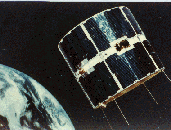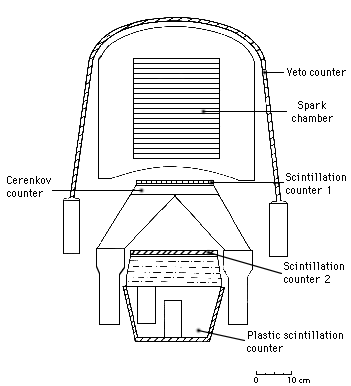|
|

COS-B
COS-B, an ESA mission, was launched from NASA’s Western Test Range by
a Thor Delta vehicle on 9 August 1975. Its scientific mission was to
study in detail the sources of extraterrestrial gamma radiation at
energies above about 30 MeV.
COS-B operated in a pointing mode with its spin axis directed towards
fixed points in the sky. Its operative time period was about 25 hours
during a 37-hour orbit. About one quarter
of this time was devoted to observations at higher galactic latitudes,
especially regions expected to contain extragalactic sources.
Pointing periods lasted four to five weeks during
the early part of the mission and up to 3 months during later observations.
A broad portion of the galactic equator
was studied deeply by means of repeatedly overlapping observations. The end
of the mission coincided with the end of available attitude gas which had
been conserved as much as possible by a careful choice of orbital manoeuvers.
Nearly 50% of the celestial sphere was viewed by COS-B.
COS-B carried a single large experiment the design and provision of
which have been the responsibility of a group of research laboratories
known as the Caravane Collaboration. The characteristics of the
instrument are described below.
The Gamma-Ray Telescope performed well throughout the mission: the only
complication being the occasional erratic performance of the spark-chamber
and the inevitable reduction in performance as the spark chamber gas aged.
This aging was, however, minimized by means of a gas-replenishment system
that permitted emptying and refilling of the spark chamber. As the rate of
gas deterioration decreased with time, it became possible to increase the
interval between flushing from its initial value of once every 6 weeks to
about once every 36 weeks before the final flushing in November 1981. The
spark chamber was still performing creditably at the end of the mission in
April 1982.
A comparison of data from overlapping observation periods enabled longterm
sensitivity changes of COS-B to be estimated. For the first three years of
the mission, the sensitivity was virtually stable. However, a slow fall-off
began to develop. From careful monitoring, curves for the empirical
correction factors were derived. Over time, the level of the background
component increased. This increase was due largely to the interaction of
cosmic rays with the massive parts of the satellite and surrounding
subsystems. Significant reductions were achieved by increasing the modulation
of the cosmic rays with the approach of the solar maximum. This effect served
to counter-balance the reduction in detector sensitivity.
The originally foreseen duration of the mission was two years, but
in fact COS-B was finally switched off on 25th April 1982, having
functioned successfully for 6 years and 8 months.
|
The Gamma-Ray Telescope consisted of a magnetic-core, wire-matrix, spark
chamber, triggered by a three-element scintillation counter telescope.
A plastic scintillator guard
counter surrounding these two units served as an anti-coincidence detector to
reject triggers due to incident charged particles and allow only gamma-rays
to be detected.
Beneath the telescope was an energy calorimeter, which absorbed the secondary
particles produced by the incident photons. For on-axis incidence, the
effective detector area reached a maximum value of ~50 cm2 at ~400
MeV. The energy resolution had its best value (~40% FWHM) at about 150 MeV and
was better than 100% up to at least 3 GeV. The experiment was described in
detail by Bignami et al. (1975).
Alongside the Gamma-Ray Telescope was mounted a proportional counter sensitive
to 2-12 keV X-rays. This detector was intended to provide synchronization of
possible pulsed gamma-ray emission from pulsating X-ray sources. The pulsar
synchronizer was also used for monitoring the intensity of radiation from
X-ray sources.
|

|
[COS-B Home]
[About COS-B]
[Archive]
[Gallery]
[Publications]
Page authors: Lorella Angelini Jesse Allen
HEASARC Home |
Observatories |
Archive |
Calibration |
Software |
Tools |
Students/Teachers/Public
Last modified: Monday, 20-Apr-2020 16:48:57 EDT
|



